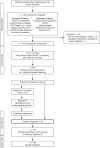Genomic Testing in Patients with Kidney Failure of an Unknown Cause: A National Australian Study
- PMID: 38861662
- PMCID: PMC11254024
- DOI: 10.2215/CJN.0000000000000464
Genomic Testing in Patients with Kidney Failure of an Unknown Cause: A National Australian Study
Abstract
Key Points:
Twenty-five percent of those with unexplained kidney failure have a monogenic cause.
Whole genome sequencing with broad gene panel analysis is a feasible diagnostic approach in nephrology.
Background: The cause of kidney failure is unknown in approximately 10% of patients with stage 5 chronic kidney disease (CKD). For those who first present to nephrology care with kidney failure, standard investigations of serology, imaging, urinalysis, and kidney biopsy are limited differentiators of etiology. We aimed to determine the diagnostic utility of whole genome sequencing (WGS) with analysis of a broad kidney gene panel in patients with kidney failure of unknown cause.
Methods: We prospectively recruited 100 participants who reached CKD stage 5 at the age of ≤50 years and had an unknown cause of kidney failure after standard investigation. Clinically accredited WGS was performed in this national cohort after genetic counseling. The primary analysis was targeted to 388 kidney-related genes with second-tier, genome-wide, and mitochondrial analysis.
Results: The cohort was 61% male and the average age of participants at stage 5 CKD was 32 years (9 months to 50 years). A genetic diagnosis was made in 25% of participants. Disease-causing variants were identified across autosomal dominant tubulointerstitial kidney disease (6), glomerular disorders (4), ciliopathies (3), tubular disorders (2), Alport syndrome (4), and mitochondrial disease (1). Most diagnoses (80%) were in autosomal dominant, X-linked, or mitochondrial conditions (UMOD; COL4A5; INF2; CLCN5; TRPC6; COL4A4; EYA1; HNF1B; WT1; NBEA; m.3243A>G). Participants with a family history of CKD were more likely to have a positive result (odds ratio, 3.29; 95% confidence interval, 1.10 to 11.29). Thirteen percent of participants without a CKD family history had a positive result. In those who first presented in stage 5 CKD, WGS with broad analysis of a curated kidney disease gene panel was diagnostically more informative than kidney biopsy, with biopsy being inconclusive in 24 of the 25 participants.
Conclusions: In this prospectively ascertained Australian cohort, we identified a genetic diagnosis in 25% of patients with kidney failure of unknown cause.
Conflict of interest statement
Disclosure forms, as provided by each author, are available with the online version of the article at
Figures





References
-
- ANZDATA Registry. 44th Report, Chapter 2: Prevalence of Kidney Failure with Replacement Therapy; 2021.
-
- USRD. 2021 USRDS Annual Data Report. Epidemiology of Kidney Disease in the United States. National Institutes of Health, National Institute of Diabetes and Digestive and Kidney Diseases. 2021.
-
- UK Renal Registry (2022). UK Renal Registry 24th Annual Report. UK Renal Registry; 2022.
Publication types
MeSH terms
Grants and funding
LinkOut - more resources
Full Text Sources
Medical
Miscellaneous

